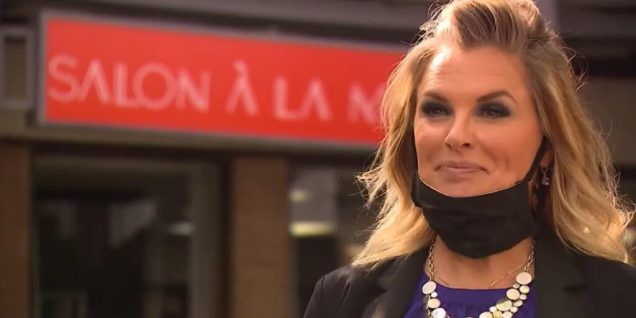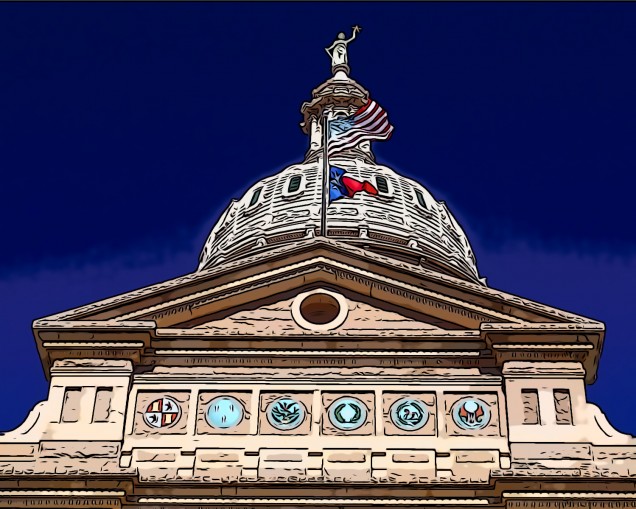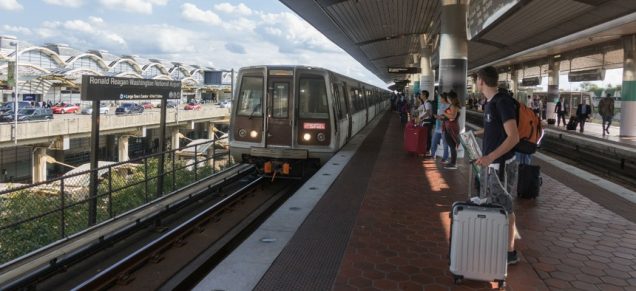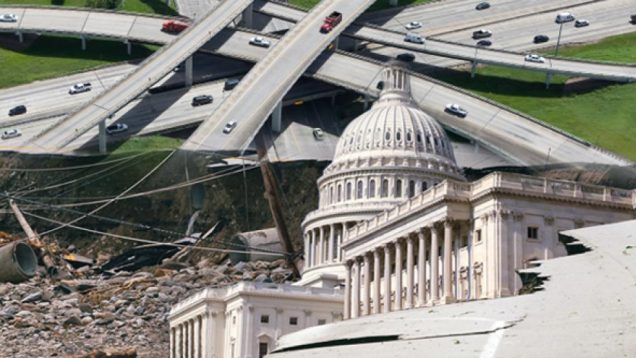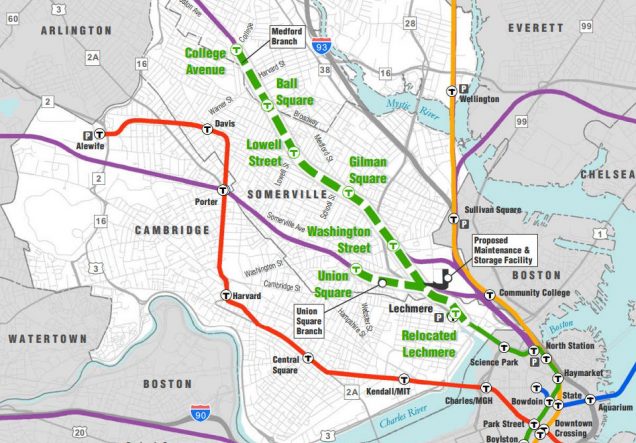Checks & Balances in a Pandemic
Recently, Shelley Luther, a Dallas based hair salon owner was jailed for refusing to close down her salon. The owner of Salon à la Mode continued operating her business despite a temporary restraining order last week from Dallas County State District Judge Eric Moyé. She continued operating despite a county official’s cease-and-desist letter ordering her to close.
As Luther faced criminal and civil contempt-of-court charges, Judge Moyé told Luther to admit her actions were selfish and wrong and promise that she would follow the law. CBS DFW reported that Luther refused responding,
“I have to disagree with you, sir, when you say that I’m selfish, because feeding my kids is not selfish. I have hair stylists that are going hungry because they’d rather feed their kids. So, sir, if you think the law is more important than kids getting fed, then please go ahead with your decision, but I am not going to shut down the salon.”
This answer did not please Judge Moyé, who immediately sentenced Luther to seven days in jail. Luther was not given an opportunity to go home or even have a phone call, if it hadn’t had been for her boyfriend her adolescent daughter would not have understood why her mother didn’t come home that night.
During the COVID-19 Coronavirus Pandemic, officials have agreed that jail is a breeding ground for the virus. In order to best protect the people, officials have quickly worked to release many non-violent prisoners for the sake of their health. Dallas county specifically released 1,000 inmates to ease crowding in the hopes to slow the spread of COVID-19 at the Dallas County jail. At a time where officials are releasing prisoners, I find it inappropriate to make an example of Luther by throwing her in jail. Not only was this action a risk to her health, but a risk to her family and those exposed to her when she would be released a week later. Additionally, if Luther had been asymptomatic there was a risk that she herself could have brought the virus into the prison.
Furthermore, Dallas County District Attorney John Creuzot announced policy reforms plans to end mass incarceration in Dallas by decreasing the use of excessively high bail amounts, no longer prosecuting most first-time marijuana offenses and not prosecuting thefts of personal items under $750 that are stolen out of necessity. These policy reforms were established to decrease the number of incoming prisoners. Again, at a time where officials are fighting to decrease prison populations, Moyé’s actions neglected to consider the bigger picture. A better alternative would have been a fine for each day she was in operation, with the money allocated to benefiting the community.
Due to public outcry, Gov. Greg Abbott modified his executive orders to remove confinement as a consequence for violating them. He stated:
“Throwing Texans in jail who have had their businesses shut down through no fault of their own is nonsensical, and I will not allow it to happen,” Abbott said in a statement Thursday. “That is why I am modifying my executive orders to ensure confinement is not a punishment for violating an order.”
His change supersedes local orders and Luther was subsequently released. Luther was fined $7,000 for violating a temporary restraining order against reopening her business. However, Lt. Gov. Dan Patrick pledged to step up and pay the fine on her behalf.
The COVID-19 Coronavirus is an unprecedented time in our nation’s history, with legislators unsure how to best regulate protective measures. State legislators have gained an enormous power with COVID-19 Coronavirus. Without a doubt aggressive government intervention has occurred during this health crisis. Historically, pandemics have led to an expansion of the power of the state. Looking towards the future, legislators will have to work to strike a balance between protective regulations and domineering policies.
 Diana Alexandra Martinez anticipates graduating from Boston University School of Law in May 2021.
Diana Alexandra Martinez anticipates graduating from Boston University School of Law in May 2021.
COVID-19’s Economic Impact: Can Amending the Fair Debt Collection Practices Act Help?
COVID-19’s impact on the world has been unsparing: it has taken thousands of loved ones and overburdened healthcare systems. Its economic impact has been no less devastating. Government-mandated shutdowns have forced many small businesses to shut their doors. Those lucky enough to remain open have seen a marked decrease in customers. A McKinsey & Company survey polling small and medium-sized businesses found that 59% of small or medium-sized businesses reported experiencing a “significant” drop in personal and business income. 25% had faced such a precipitous drop that they expected they would have to file for bankruptcy in the coming months. This impact will have a broad effect: these businesses represent 48% of the U.S. economy and employ over 60 million people.
COVID-19 has also been unsparing when it comes to consumers. Not only are those employed by small or mid-sized businesses losing their jobs, but even those working at large international companies are also losing their jobs or facing pay cuts. Self-employed individuals have seen their business opportunities vanish. Right now, because of moratoria on foreclosures, evictions, and debt collection, these issues are looming when the overall economy begins to resume. Without any intervening forces, a wave of evictions, foreclosures, repossessions, and bankruptcies is likely to come.
Currently, little protects consumers and small businesses during emergencies or disasters. While larger institutions are expected to have plans, even participating in stress tests with regulators, small businesses usually do not have such protective measures. Indeed, because so many operate on a thin profit margin, investing in plans to address something that seems unlikely to ever happen may seem like a waste of money. Moreover, consumers are not always going to be financially prepared either. The average American has $8,863 in their savings account. This number decreases with age: for example, young single adults under 34 have an average of $2,729 in savings. There are racial disparities too, with an average of $1,500 for Hispanic and $1,000 for Black savings account balances. (Note that this data does not include the unbanked, which is largely composed of Black and Hispanic households.)
In March 2020, Senator Sherrod Brown (D-Ohio) introduced the Small Business and Consumer Debt Collection Emergency Relief Act of 2020 (the “Act”). The Act amends the Fair Debt Collection Practices Act (“FDCPA”) to provide temporary forbearance periods after “major disasters or emergencies.” The Act could provide much-needed relief to small businesses and American consumers by expanding on current protections currently provided by the FDCPA.
Current Protections
The FDCPA became law in 1978. Its purpose was to crack down on abusive debt collection tactics. In drafting the law, Congress found that abusive debt collection practices led to “personal bankruptcies, to marital instability, to the loss of jobs, and to invasions of individual privacy.” The FDCPA covers several types of consumer debts: mortgage, credit card, student loan, and medical debts, just to name a few. Debts owed by businesses are currently not covered by the FDCPA.
One of the biggest protections afforded under the FDCPA is limiting how and when a debt collector can contact a debtor. Debt collectors cannot harass debtors, misrepresent what can occur if the debtor fails to pay, or contact the debtor in the middle of the night. While the FDCPA is imperfect—consumers regularly report violations—it provides an avenue of recourse and is regularly enforced.
The Act’s Proposals
 The Act seeks to amend the FDCPA in several ways. First, the Act amends section 3 of the FDCPA to restrict debt collection during a national disaster or emergency. The Act defines “national disaster or emergency” two ways: (1) one declared by the president under section 401 of the Robert T. Stafford Disaster Relief and Emergency Assistance Act; or (2) “an emergency involving Federal primary responsibility that is determined to exist by the President” under section 501 of that act. Next, the Act prohibits debt collectors from numerous actions ranging from charging higher fees or interest rates to seizing the property or asset at issue. Moreover, the Act pauses any legal action against the debtor, even if the proceeding began before the disaster was declared. Finally and crucially, the Act extends FDCPA protections during national disasters or emergencies to small businesses.
The Act seeks to amend the FDCPA in several ways. First, the Act amends section 3 of the FDCPA to restrict debt collection during a national disaster or emergency. The Act defines “national disaster or emergency” two ways: (1) one declared by the president under section 401 of the Robert T. Stafford Disaster Relief and Emergency Assistance Act; or (2) “an emergency involving Federal primary responsibility that is determined to exist by the President” under section 501 of that act. Next, the Act prohibits debt collectors from numerous actions ranging from charging higher fees or interest rates to seizing the property or asset at issue. Moreover, the Act pauses any legal action against the debtor, even if the proceeding began before the disaster was declared. Finally and crucially, the Act extends FDCPA protections during national disasters or emergencies to small businesses.
The Act is a way of addressing some of the consumer protection shortcomings of the CARES Act. For example, there is a 120 day moratorium on foreclosures and evictions, but only for those who have federally-backed mortgages, live in buildings financed by federally-backed mortgages, or receive rental funding through a federal program. While this covers a significant number of individuals and homes, about 30% of Americans are left out of this provision. The debt collection moratorium under the Act would extend to those Americans. It also addresses the issue the COVID-19 pandemic has made clear: small businesses suffer when they are forced to shut down, as they may not always have the resources or option to continue operating virtually. Their financial troubles largely came as the result of a forced shutdown. More generally, the Act’s amendments can cover future national emergencies or pandemics.
While this is not an overall solution to COVID-19’s economic impact, it can provide some relief to consumers and small businesses. It may allow people to be more understanding of opening up gradually rather than quickly, too. While it does not solve a reduced or lack of income, having some assurance that the car will not be repossessed or a debt collector will not be regularly calling can provide some much needed relief in what has been a stressful time. Currently, debtors do not have such relief. Despite the pandemic, debt collectors have still been calling consumers. In Massachusetts, the Attorney General’s Office sought to ban debt collection during the height of the pandemic. However, a federal judge ruled against the state’s emergency resolution. FTC guidance is not particularly helpful either: it recommends talking things out with the debt collector and asking that they stop calling. Congress has already done a lot through the CARES Act to help consumers during the pandemic. To further assist them, Congress should pass Senator Brown’s bill.
 Kathryn Buckley anticipates graduating from Boston University School of Law in May 2021.
Kathryn Buckley anticipates graduating from Boston University School of Law in May 2021.
Is the Johnson Amendment Constitutional?
My previous Dome blog entry discussed the Johnson Amendment and the fight that has surrounded the amendment since its creation in the 1950s. The Johnson Amendment was added to Section 501(c)(3) of the U.S. tax code by then-Senator Lyndon B. Johnson to limit the political activity of 501(c)(3) organizations. The Amendment prohibits 501(c)(3) organizations from endorsing or opposing political candidates. Many organizations have been trying to repeal the Johnson Amendment for years, and many argue (including members of Congress) that it violates the First Amendment of the U.S. Constitution.
Two vocal opponents of the Johnson Amendment (and the sponsors of the Free Speech Fairness Act in both houses of Congress) Senator James Lankford and Congressman Steve Scalise argue that the Amendment must be repealed to protect the First Amendment rights of 501(c)(3) non-profit employees. They argue the Bill of Rights protects the right of all Americans to freely express their ideas and opinions without persecution from the government, and the Johnson Amendment violates this right by stripping 501(c)(3) employees from being able to speak their minds about political issues. As discussed in my previous post, the Johnson Amendment prohibits 501(c)(3) employees from endorsing or opposing candidates, and violations of the Amendment risks punishment by the IRS either by fine, revocation of the organization’s tax-exempt status, or both. This, therefore, begs the question of whether the Johnson Amendment does in fact violate the First Amendment. This Dome blog post will look at legal precedent to see if the Amendment has been challenged for its constitutionality in the past, and if so, the arguments the court made in their decision.
Before going into court cases about whether or not the Johnson Amendment actually violates the First Amendment, it is important to look at the text itself. The text of the First Amendment reads:
“Congress shall make no law respecting an establishment of religion, or prohibiting the free exercise thereof; or abridging the freedom of speech, or of the press; or the right of the people peaceably to assemble, and to petition the government for a redress of grievances.”
Members of Congress and other organizations who oppose the Johnson Amendment mainly argue that it violates the freedom of speech, which is in fact why the current bill before Congress attempting to repeal the Amendment is titled the “Free Speech Fairness Act.” Within the text of the First Amendment, they argue that the Johnson Amendment is “abridging the freedom of speech” of 501(c)(3) tax-exempt nonprofit employees, but in particular religious ones, such as pastors, priests, and rabbis.
But has the constitutionality of the Johnson Amendment actually been determined by the Supreme Court as it applies to religious organizations? The answer, unfortunately, is no. However, two U.S. Court of Appeals circuits have upheld the Amendment as constitutional in the past when applied to religious organizations. The first case, Christian Echoes Nat'l Ministry v. United States (1972), involved a nonprofit religious corporation contesting the revocation of its 501(c)(3) tax-exempt status by the IRS as punishment for violating the Johnson Amendment. Through various appeals and remands, the ultimate holding by the Tenth Circuit Court of Appeals was that the organization no longer qualified as a tax exempt organization under section 501(c)(3) of the tax code. As one argument against the revocation of their status, Christian Echoes argued the Johnson Amendment was unconstitutional and violated their right to free speech. However, the court held that “in light of the fact that tax exemption is a privilege, a matter of grace rather than right... the limitations contained in Section 501(c) (3) withholding exemption from nonprofit corporations do not deprive Christian Echoes of its constitutionally guaranteed right of free speech.” Christian Echoes Nat'l Ministry v. United States, 470 F.2d 849, 857 (10th Cir. 1972). The court therefore determined the taxpayer must refrain from these political activities to obtain “the privilege of exemption,” which Christian Echoes benefited from until their status was revoked.
The argument made by the court in Christian Echoes is very similar to the argument made by proponents of the Johnson Amendment, such as the Freedom From Religion Foundation, who argue because religious organizations benefit essentially from a government subsidy, in exchange for that subsidy they relinquish some of their rights. These rights can at any time be reclaimed, but at the cost of losing the subsidy, ultimately leaving the choice between the two up to individual organizations.
The District of Columbia Circuit Court of Appeals has also taken up this issue more recently in Branch Ministries v. Rossotti (2000), regarding the constitutionality of the Johnson Amendment, but for violation of a different part of the First Amendment. In this case, a church had its tax-exempt status revoked for intervening in political campaigns, violating the Johnson Amendment. The church argued that revoking their tax-exempt status was a violation of the Free Exercise clause of the First Amendment, as in violating their right to freely exercise religion. To show the Free Exercise clause had been violated, the church had to establish their “free exercise right has been substantially burdened.” Branch Ministries v. Rossotti, 211 F.3d 137, 142 (2000). The court, however, held the Johnson Amendment did not violate the First Amendment because the church failed to establish that their free exercise right had been substantially burdened. Despite the claim by the church that by revoking their tax exempt status would threaten its very existence, the court determined this was overstated because the impact of revocation “is likely to be more symbolic than substantial,” because if they stop intervening in political campaigns they can regain their tax-exempt status, and even if they do not, “the revocation of the exemption does not convert bona fide donations into income taxable to the Church.” Therefore, the burden is not substantial enough to be considered a violation of the First Amendment. See, Branch Ministries, 211 F.3d at 142-143.
It seems currently that courts are finding the Johnson Amendment does not, in fact, violate the First Amendment. The Supreme Court has said in the past they believe tax benefits nonprofits are given are “a form of subsidy that is administered through the tax system,” which seems in line with the view of supporters of the Johnson Amendment and these two Court of Appeals cases. See, Regan v. Taxation with Representation, 461 U.S. 540, 544 (1983). They have not, however, delivered a decision on the constitutionality of the Johnson Amendment as it applies to religious organizations. Therefore, despite the Court of Appeals cases, the fight over this issue is unlikely to end until the Supreme Court formally rules on the Johnson Amendment as it applies to religious organizations once and for all.
 Kate Lipman anticipates graduating from Boston University School of Law in May 2021.
Kate Lipman anticipates graduating from Boston University School of Law in May 2021.
COVID-19 is a Perfect Opportunity to Reinvent America’s Mass Public Transit
As the coronavirus (Covid-19) has swept the globe, its impact on global health has been massive. However, this pandemic is not only wreaking havoc on the world’s physical health, but also its financial health. Throughout March 2020, as governments globally imposed restrictions on movement and on business, stocks plummeted. In response, the Federal Reserve slashed interest rates and has attempted to provide new sources of funding for business. Additionally, the federal government enacted a $2 trillion stimulus package. This package includes direct aid for businesses as well as individuals, in addition to support for the medical industry and other key parts of the economy. However, this bill merely provides a one-time cash infusion for a struggling and increasingly desperate economy. The US approach differs from what other countries have provided their citizens during this crisis. Other methods are more akin to ongoing support rather than a one-time payment. In fact, the UK government, in an attempt to curb unemployment, has promised to subsidize up to 80% of any worker’s salary who is facing unemployment, up to $2,900 a month. Many other countries have followed this model of providing continuing support to workers and businesses in an effort to limit unemployment. This is in contrast to the United States where, even after this stimulus was enacted, unemployment figures in the United States have climbed precipitously. Consequently, there have been discussions in Washington of a large infrastructure spending bill, akin to several New Deal programs, that would create thousands of jobs to help the United States economically recover as the health crisis recedes.
It has been reported that this infrastructure bill could be a multi-trillion dollar project. However, it is not clear that an agreement will be reached. For the duration of the Trump Presidency, infrastructure has been seen as a potential compromise issue that both Democrats and Republicans could support, yet an agreement has been elusive. Earlier this year, House Democrats released a proposal that would direct $760 billion towards rebuilding American highways, airports, and other infrastructure, with $10 billion going towards building community health centers. Additionally, this proposal included $329 billion for transportation systems, including $105 billion for transit agencies and maintenance. However, Trump and Congressional Democrats were not able to agree on a compromise agreement. Now that there is increased political pressure to provide jobs, an infrastructure deal is more likely than ever to occur. When it does, Congress should include vigorous funding specifically for mass transit.
First, the construction of mass transit can achieve the short term goal of the infrastructure bill: to create jobs. In fact, a recent light rail construction project between Durham County and Orange County in North Carolina was projected to create 20,000 jobs at a cost of just $2.5 billion. While it is unlikely that these job returns per investment would hold constant, these numbers suggest that a $1 trillion investment could yield 8,000,000 jobs. This would put a sizeable dent in to projected 20 million unemployment claims that could be filed as a result of the pandemic and subsequent economic downturn.
However, the United States should not throw money at a short term solution, without considering long term objectives as well. Investment in mass transit not only would result in short term jobs, but it would also yield many long term benefits that would impact society for a substantial period of time.
Studies at Harvard University indicate that commuting time is the single strongest factor in predicting the odds of escaping poverty. While this may be a function of poverty inherently being a hard burden to escape and wealthier individuals live near good transit options, this may not be the sole explanation. After housing, transportation is the biggest expense for most Americans, especially those settled along the urban fringe. In fact, 44% of all multifamily section 8 properties in the nation spend on average more than 15% of their income on transportation costs, effectively making these properties unaffordable. Yet increased availability of mass public transit could help solve this issue. Undeniably, mass transit is cheaper than the alternative: owning a car. On average a household can save around $10,000 annually by owning one fewer car and utilizing public transit.
However, American mass transit systems lag behind those of other countries. New York is the only US city where rail network ridership has increased since 2012. North America as a whole only accounts for 3.7 billion of the world’s 53 billion rail passengers. Ridership in Asia increased to 26 billion between 2012 and 2017, Europe accounts for 10 billion riders, and Latin America 6 billion. Further, American cities with popular transit systems are generally located in the north and on the coasts of the country. While many attribute this lack of public transit to America’s sprawl, a look at Canada, an equally car centric country, dispels this theory. Toronto, Montreal, and Vancouver all have buses, rapid transit, and commuter rail systems. Rather, reports have postulated that American mass transit systems have failed to gain steam because the demand for them is not present, and American’s would rather drive. Further, demand could be low because in cost cutting efforts, many bus and rail lines run less than once every 30 minutes. This lack of service restricts people’s lives in such a way that anyone who can drive, will drive.
Therefore, as Congress and the President work out an infrastructure bill in the coming days and weeks, they should invest heavily in mass public transit. Not only will this plan help solve the initial goal of providing jobs to those left unemployed by COVID-19, but it will also provide significant long term benefits to lower income groups. However, this bill must also create a framework to continue to support mass public transit projects. While it is undoubtedly beneficial to build these projects, their long term impact can only be realized if they are funded sufficiently to become a viable and preferable option to cars. Legislators must ensure that this massive expenditure is structured in a way that it can provide lasting change and provide more benefits than a one time influx of cash ever could.
 Gray Louis anticipates graduating from Boston University School of Law in May 2021.
Gray Louis anticipates graduating from Boston University School of Law in May 2021.
Funding the MBTA: Getting Derailed Plans Back on Track
Taking the T
The transit system of Eastern Massachusetts, governed by the Massachusetts Bay Transportation Authority, has been the subject of much ire by residents of Greater Boston for decades, particularly where the subway, or “T,” is concerned. A prime example is last year’s decision to raise fares by 6% despite continual failures in service, such as a recent derailment on the Red Line and power shutdown on the Blue Line. As the oldest subway system in North America, many of the T’s problems stem from decades- or even century-old design decisions which are impractical to redo today. For example, its hub-and-spoke layout emphasizes access to downtown Boston at the expense of ease of travel between the edges of the system.
Broke, But Not Broken
However, the primary barrier to the T being the efficient, functional transit system that Boston needs it to be is insufficient funding relative to necessary maintenance and upgrades, not to mention its current debt load. Though the MBTA system as a whole sees more than $2 billion in annual revenue, it still endures annual operating losses of more than $36 million. Significantly, the majority of its revenue does not come from operations, i.e. fares collected, but rather from sales tax and local assessment contributions. For nearly twenty years, a “penny” of all non-meal-and-drink sales tax revenue in Massachusetts has been dedicated to the MBTA budget. Because this source of tax revenue has not grown as anticipated, the MBTA budget has consequentially fallen short of expectations by well over $200 million per year. Meanwhile, costs of new projects continue to balloon. The cost of an upgraded fare collection system, originally budgeted at just over $700 million, has now grown to over $900 million.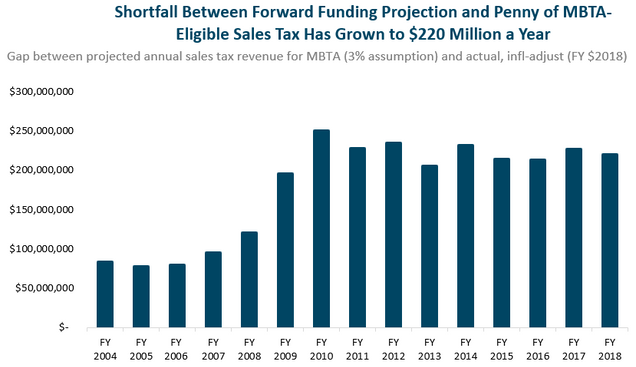
Boston City Councilor Michelle Wu argues that incremental fixes and patching of problems is insufficient; rather, we must invest in the system as a whole with a focus on expanding access. The necessity of serious capital investment became especially apparent after historic blizzards in early 2015 forced a system-wide shutdown. Wu has pointed to Governor Charlie Baker’s reluctance to act as an obstacle to the requisite overhaul the T needs. In response to pressure from her and other transit advocates, last summer Gov. Baker announced plans to accelerate an ongoing five-year, $8 billion capital investment program which kicked off in early 2019. The program aims to provide new rapid-transit buses and train cars, modernize the Red and Orange Lines, and fund a major expansion of the Green Line into underserved areas of Somerville and Medford. The latter, a long-suffering project decades in the making, is an example of the importance of major investment in transit: once complete, the percentage of Somerville residents within walking distance to light rail will increase to 80%, up from a current 20%. Gov. Baker’s acceleration includes more aggressive closures to allow for infrastructure work, more inspections and maintenance, negotiations with contractors, and the creation of a new team of MBTA personnel with the flexibility to work on multiple projects.
Capital Infusions
Even so, continued problems, such as the aforementioned Red Line derailment, prompted Gov. Baker to propose an $18 billion bond bill for transportation throughout the Commonwealth last year, providing money to the entire Massachusetts Department of Transportation, including a $5.7 billion slice for the MBTA. This bill, An Act Authorizing and Accelerating Transportation Investment, most recently received approval, with an amendment, from the House Committee on Bonding, Capital Expenditures and State Assets and moved before the House Committee on Ways and Means in late February, 2020. This Act would fund road and bridge repairs, MBTA upgrades, and the electrification of regional transit services, as well as contribute to big projects such as Cape Cod Canal bridges and the Green Line Extension. The bill also provides support for improving pavement on public roads and building small bridges as well as help for municipalities seeking to make their roads more cyclist- and pedestrian-friendly. Other provisions aim to reduce traffic congestion and greenhouse gas emissions by building bus lanes and working to reduce bottlenecks. Transportation Secretary Stephanie Pollack highlighted the importance of action on other projects which complement improved transit service to maximize the impact of the bill. Such legislation includes Gov. Baker’s proposed Housing Choices Act, which would streamline zoning approval for certain housing projects.
This past January, Gov. Baker also proposed a $135 million budget increase for the MBTA, possibly in response to a scathing December 2019 report by the Safety Review Panel which found deficiencies “in almost every area” of the MBTA system. A major criticism was the recent over-emphasis on capital improvements and not enough support for regular maintenance and safety, with staff being diverted away from the latter. However, it is unclear how exactly the infusion of funding would be spent.
It should be noted that there currently remain $743 million in outstanding senior revenue bond loans to MassDOT, though the Department maintains an A+ rating for borrowing. Though the Act Authorizing and Accelerating Transportation Investment would be funded by further borrowing via bonds, its original version allocated half of all revenue from a potential greenhouse gas cap-and-trade program with other states in the region to public transit, creating a stream of revenue as well as encouraging more fuel-efficient cars. However, that provision was stricken by the Transportation Committee, which argued that they cannot allocate funds to a program that does not yet exist. Lawmakers instead plan to increase fees on transportation network companies and deeds excise taxes.
COVID-19 Crisis
The amendments, including those made earlier by the House Committee on Transportation, include the elimination of $50 million in business tax cuts to encourage employees to work from home and thus reduce traffic congestion, a quaint decision in the midst of the COVID-19 pandemic which has forced millions to work from home anyway. The MBTA has been understandably hit hard, and as of April, ridership on the T was down more than 90% from late February, with bus service down nearly 80%. Anticipated losses this year exceed $213 million due to a 95% plunge in fare collection and drops in revenue from advertising and state sales tax. MassDOT hopes to cover the loss with an expected infusion of $840 million in federal funds through the CARES Act. Meanwhile, the MBTA has reduced service, instituted cleaning and sanitizing regimes for vehicles, and has begun requiring employees and remaining riders to wear face masks.
Needless to say, major investment decisions as of this writing have been put on hold. However, once this crisis has passed, it is critical that Massachusetts act to ensure its transit services remain a functional asset to the people of the Greater Boston Area and beyond.
 Kellen Safreed anticipates graduating from Boston University School of Law in May 2021.
Kellen Safreed anticipates graduating from Boston University School of Law in May 2021.
Mandatory Arbitration Clauses, Class Action Waivers, and the Need to Pass the FAIR Act
Mandatory arbitration clauses and class action waivers have become a fact of life for many American employees. A mandatory arbitration clause is contractual language that a company has a worker sign requiring that worker to resolve legal disputes in private arbitration — “a quasi-legal forum with no judge, no jury, and practically no government oversight”. A class action waiver is contractual language that a company has a worker sign that forfeits that employee’s right to file any claims collectively with other similarly situated workers. These provisions effectively strip away the rights of employees to challenge their employers in court with claims alleging wage and hour violations, discrimination, sexual harassment, and more. Congress must enact the FAIR Act so that our legal system vindicates employee rights to seek justice, access our courts, and end abusive employer practices.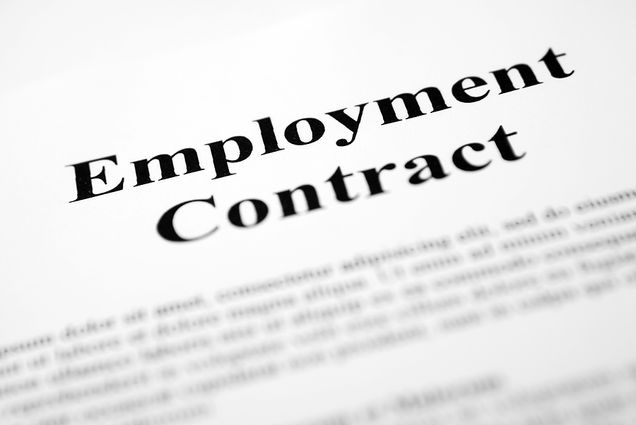
Historically, it was commonplace for American courts to decline legal enforcement of arbitration agreements, especially adhesive contracts (Epic Sys. Corp. v. Lewis, 138 S. Ct. 1612 (2018)). When Congress passed the Federal Arbitration Act (FAA) in 1925, legislative history suggests that the bill was intended to “enable merchants of roughly equal bargaining power to enter into binding agreements to arbitrate commercial disputes,” not to enforce mandatory arbitration agreements and class action waivers against workers in employment contracts. Members of Congress envisioned the FAA to provide an “opportunity to enforce…an agreement to arbitrate, when voluntarily placed in the document by the parties to it”; they did not intend to enforce the law in cases “where one party sets the terms of an agreement while the other is left [to] take it or leave it.” Until recently, courts upheld this interpretation of the FAA’s history and purpose (Prima Paint Corp. v. Flood & Conklin Mfg. Co., 388 U. S. 395 (1967))).
However, starting in the 1980s, this all changed. In Gilmer v. Interstate/Johnson Lane Corp. (500 U. S. 20 (1991)), the Supreme Court held that the FAA requires mandatory arbitration agreements to be enforced against claims arising under the Age of Discrimination in Employment Act of 1967 (ADEA) antidiscrimination law. Later, in Circuit City Stores, Inc. v. Adams (532 U. S. 105 (2001)), the Court held that the FAA’s §1 exemption for employment contracts involving “any...class of workers engaged in foreign or interstate commerce” should be construed narrowly to only apply to employment contracts involving transportation workers.
These landmark decisions spurred a widespread use of arbitration clauses in employment contracts, and emboldened employers to challenge state common law and statute protections that historically limited the enforceability of mandatory arbitration provisions and class action waivers. In 2011, the Supreme Court effectively overturned an earlier 2005 California Supreme Court case that had found legal protections for employees and consumers against the enforcement of class action waivers (AT&T Mobility LLC v. Concepcion, 563 U.S. 333 (2011)). In Am. Express Co. v. Italian Colors Rest. (570 U. S. 228 (2013)), although Respondents argued that the arbitration and class action waiver provisions in their contract were unenforceable because they made effective vindication of their legal rights prohibitively expensive, the Supreme Court held that: 1) the FAA presumptively requires enforcement of contracts of adhesion; and 2) the “effective vindication rule” does not require that one’s assertion of rights be affordable or not cost-prohibitive, but rather only requires that one’s assertion of rights be not prohibited outright.
Eventually, the Supreme Court directly addressed the question of whether employment contracts that include mandatory arbitration provisions are enforceable in Epic Sys. Corp. v. Lewis. Employees argued that under the “saving clause” of the FAA, contractual language that violates the National Labor Relations Act (“NLRA”) right to engage in “other concerted activities for the purpose of collective bargaining or other mutual aid or protection” can be found unenforceable consistent with the FAA; this interpretation was adopted by the Ninth Circuit and consistent with NLRB precedent. However, the Supreme Court held that neither the “saving clause” nor the NLRA altered the legal requirement to enforce arbitration agreements prescribed by the FAA. The Court reasoned that state unconscionability defenses were not valid if they “interfer[ed] with fundamental attributes of arbitration,” such as individualized proceedings. Furthermore, the Court found that §7 of the NLRA did not guarantee employees the right to class or collective action procedures. Finally, the Court held that Chevron shouldn’t apply – based upon the NLRB’s 2012 decision – because: 1) the NLRB was interpreting the FAA, an act that the NLRB doesn’t administer; 2) the NLRB and the Solicitor General dispute the NLRA’s meaning and application; and 3) “there is no unresolved ambiguity for the Board to address.”
 With arbitration clauses effectively privatizing our judicial system for many American workers, employees face information asymmetry and an imbalance of negotiating power with firms, and are therefore unable to contract under fair conditions. By implementing changes to our laws that prohibit employers from forcing employees to sign away their rights, society can improve both economic efficiency and equity within labor markets. Congress can do this by enacting the Force Arbitration Injustice Repeal (FAIR) Act. This Act, passed by the House of Representatives in September of 2019, would ban companies from requiring workers and consumers to resolve legal claims in private arbitration, and would invalidate current mandatory arbitration clauses and class action waivers that have already been signed in consumer or employee contracts.
With arbitration clauses effectively privatizing our judicial system for many American workers, employees face information asymmetry and an imbalance of negotiating power with firms, and are therefore unable to contract under fair conditions. By implementing changes to our laws that prohibit employers from forcing employees to sign away their rights, society can improve both economic efficiency and equity within labor markets. Congress can do this by enacting the Force Arbitration Injustice Repeal (FAIR) Act. This Act, passed by the House of Representatives in September of 2019, would ban companies from requiring workers and consumers to resolve legal claims in private arbitration, and would invalidate current mandatory arbitration clauses and class action waivers that have already been signed in consumer or employee contracts.
Passage of the FAIR Act would protect over 60 million American workers who have signed contracts with mandatory arbitration clauses and class action waivers. Marginalized communities (including women and communities of color), who are the most likely to be subjected to arbitration agreements because they constitute a huge share of the labor pool in industries like education, retail, and healthcare that use mandatory arbitration agreements and class action waivers the most, would greatly benefit from the FAIR Act by gaining access to the courts to litigate sexual harassment claims, sex discrimination claims, and racial discrimination claims. Furthermore, passing the FAIR Act would reduce the bias in employment disputes against employee interests, resulting from the conflict of interest between employers and arbitrators (employers pick the arbitration firm that will hear their case, pay the cost to hire the arbitrator or panel of arbitrators, and usually have a “cozy” relationship with the arbitrators they hire). Studies have found that, because of the “repeat player effect,” arbitrators are often biased toward employers who continuously pick them to handle their cases; Professor Amsler from Indiana University Bloomington demonstrated that “workers are nearly five times less likely to win their case if the arbitrator had handled past disputes involving her employer.”
The FAIR Act has been introduced by Senator Blumenthal in the Senate chamber, and has thirty-eight co-sponsors, but lacks any Republican co-sponsors and has failed to receive any congressional action since it was initially referred to the Committee on the Judiciary. While passage remains unlikely, it is incumbent on Congress to continue fighting for the FAIR Act. Given the Supreme Court’s conservative crusade to interpret the FAA in a way that guts workers’ rights over the last forty years, it is crucial that Congress pass this bill to promote economic, labor, humanitarian, and social justice for all Americans.
 Samuel Shepard graduated from Boston University School of Law in May 2020.
Samuel Shepard graduated from Boston University School of Law in May 2020.
How We Gonna Pay Last Year’s Rent?* Advocating Rental Housing Reform in Boston
*Adam Pascal et al., Rent, on, Rent Original Major Picture Soundtrack (Warner Records 2005).
Unprecedented Rental Relief in Unprecedented Times
The novel coronavirus is disrupting so much of life in Boston, MA. From school and business closings to rising unemployment rates, more residents than ever are concerned than ever with affording basic essentials—including the rent due on the first of each month. The reality of how to pay for rent is substantial in Boston, where an estimated sixty percent of over seven-hundred thousand residents rent, making it the fourth most densely populated region in the United States after the New York Metro Area, Greater Los Angeles, and South Florida Metro Area.
As of April 20, Gov. Charlie Baker signed legislation placing a moratorium on non-emergency residential evictions and foreclosures during the novel coronavirus pandemic. Under this moratorium, landlords are not able to file eviction notices for the next 120 days, or for 45 days from the lifting of Gov. Baker’s emergency declaration, whichever comes first. Additionally, the moratorium bans late fees and negative reporting to credit-rating agencies for unpaid rents if tenants can prove pandemic-related issues with late payments.
Figure 1: Baker signs bill blocking evictions during coronavirus crisis (Tim Logan, Baker signs bill blocking evictions during coronavirus crisis, Boston Globe (Apr. 20, 2020))
Additionally, the federal government has passed a $2 trillion coronavirus rescue package—the CARES Act—including a 120-day moratorium on most evictions at properties that receive federal subsidies or that federal entities insure. Notably, the CARES Act does not apply to eviction proceedings in progress before President signed the legislation on March 27th, or to eviction cases meeting a number of exceptions discussed in the Act.
On April 4, Mayor Martin Walsh announced $3 million in city funds to help Boston residents at risk of losing their rental housing due to the novel coronavirus pandemic. The Rental Relief Fund is managed by the Office of Housing Stability, in partnership with non-profit partners Metro Housing Boston and Neighborhood of Affordable Housing. This program will provide eligible applicants with up to $4,000 in financial assistance to be used for rent. Additionally, the funding will only be available to households earning less than 80 percent of Area Median Income (AMI), which is $72,000 for a two-person household. A significant portion of these funds are reserved for households with extremely low incomes (under $25,000 for a single-person household), and very low-incomes or less than $42,000 for a single person (50 percent AMI). "In the midst of the COVID-19 pandemic, a national crisis at a scale not seen in our lifetime, it is imperative that all levels of government exercise all possible tools to ensure the health and safety of our residents, and to keep them stably housed," said Mayor Walsh. (Thomas Stackpole, How Did Renting in Boston Become Such a Nightmare?, Boston Magazine (May 30, 2020))
The Rent is Due Every Day: Framework Changes to the Rental Housing Market
The efforts of the federal and MA government to address the needs of renters in Boston are necessary measures to help residents maintain stable housing in these unprecedented times. Nevertheless, it is merely band-aid for the greater problem of the daily struggle for low-income Boston residents to make rent, or even establish tenancies.
The Commonwealth provides financial assistance through the Residential Assistance for Families in Transition (“RAFT”) program in which up to $4,000 may be awarded to applicants to establish tenancies. However, with Fair Market Rent (“FMR”) rising in Massachusetts to $1,425 for a one-bedroom and $1,758 for a two-bedroom apartment, the $4,000 allocation from the RAFT program may not be enough to overcome the high bar to starting tenancies in Massachusetts for low-income families who are homeless or at risk of becoming homeless. The barriers to entry establishing a tenancy in MA include: the first full month of rent, last full month of rent, security deposit equal to the first month’s rent, broker fee equal to first month rent, and one-time fee covering installation of a new key and lock. The cumulative effect of these fees requires upwards of four months of rent to gain tenancy in Massachusetts. The impact of this legislation disproportionately bar low-income residents from securing and maintaining affordable housing.
When federal and state aid to low-income residents is not sufficient to help families begin tenancies, it is imperative to look to alleviating some of these barriers to entry to affordable housing. In addition to being the fourth most densely populated region in the United States, Boston also is also boasts the fourth-highest average rental market. Compared to the rental markets of New York City and Los Angeles, the Boston market imposes the broker fee, equal to one full month’s rent, which may be borne by the tenant. This differs to New York’s recent ban on broker fees, and Los Angeles’ burden shifting of broker fees to the landlord.
Massachusetts should consider following in the footsteps of their metropolitan neighbors and propose legislative action banning broker fees in order to decrease the burden to tenants establishing tenancy. In the alternative, the legislature should support the proposed bill H.4452: An Act Relative to Consumer Rights of Renters which shifts the burden of paying broker fees to the landlord with the following language: “[t]his fee shall only be paid by the lessor of the residential dwelling and shall not be transferred to or paid by an other party.”
Conclusion
The novel coronavirus is truly a pandemic affecting every area of daily life, but it’s disparate impact to low-income families towards their struggle to afford housing illuminates a deeper issue that needs to be addressed with expediency. The cost of securing and maintaining a tenancy in Boston is simply too high and not sustainable. As a result, the legislature should tackle broker fees directly to allow more residents the opportunity to initiate affordable tenancies in Boston. This may take the form of eliminating broker fees in their entirety, or shifting the burden to landlords to pay the fee, but ultimately the legislature should take action to protect the most vulnerable member in this time—low-income residents trying to establish and maintain affordable housing for themselves and their families.
 Alexandra Trobe anticipates graduating from Boston University School of Law in May 2021.
Alexandra Trobe anticipates graduating from Boston University School of Law in May 2021.
Post Haste: Why Reform of the US Postal Service is a Matter of Urgent National Concern
President Trump has been antagonistic to the United States Postal Service since the early days of his administration. In his plan for government reorganization, he called for the privatization of the post office. He has tweeted that the post office should charge Amazon more to deliver packages. Most recently, he has threatened to veto COVID-19 emergency funding if it contains direct funding for the post office.
 Ultimately, change is needed with regard to the postal service. However, that change needs to be an expansion in the role of the post office in public life rather than a diminution of its functions. Because the postal service has a universal service obligation to provide all aspects of service at an affordable price to all communities in the United States, it already represents a vital service to thousands of Americans who are not perceived as “profitable” to serve by private companies. Leveraging that power by expanding the role of the postal service can be a powerful boon to democracy and an agent of financial inclusion for underserved communities. Pending legislative proposals exist to address these concerns, and urgent action is needed. These proposed expansions to the role of the postal service require an additional legislative intervention to support its financial viability. To increase access, facilitate participation, and promote strong and healthy communities, three key legislative reforms to the post office are urgently needed.
Ultimately, change is needed with regard to the postal service. However, that change needs to be an expansion in the role of the post office in public life rather than a diminution of its functions. Because the postal service has a universal service obligation to provide all aspects of service at an affordable price to all communities in the United States, it already represents a vital service to thousands of Americans who are not perceived as “profitable” to serve by private companies. Leveraging that power by expanding the role of the postal service can be a powerful boon to democracy and an agent of financial inclusion for underserved communities. Pending legislative proposals exist to address these concerns, and urgent action is needed. These proposed expansions to the role of the postal service require an additional legislative intervention to support its financial viability. To increase access, facilitate participation, and promote strong and healthy communities, three key legislative reforms to the post office are urgently needed.
Postal Banking
The first potential legislative reform is the reintroduction of postal banking. Prior to 1967, the post office served an important role in providing basic financial services to thousands of Americans in rural and underbanked communities. Because the post office is a universal service, ensuring access to reliable mail service everywhere in the country, it was uniquely situated to ensure access to financial services like access to small loans, checking and savings accounts, and basic transactional services to communities not deemed profitable for traditional financial institutions to serve.
In 2017, 6.5% of households in the United States, or nearly 8.5 million households, were unbanked – meaning they had no formal bank account—and an additional 24.2 million were underbanked. These individuals are therefore forced to fringe or informal financial institutions, which often more costly to them because of high interest rates and lack the federal protection and oversight of traditional financial service providers. Re-establishing postal banking would create a formal institution to serve the basic financial needs of these communities, allowing them a greater degree of financial inclusion and economic participation without resorting to check cashers, payday lenders, or other informal actors.
Postal banking is a popular proposal with a historical precedent that can be reenacted to improve economic and financial inclusion for marginalized communities. Senator Gillibrand introduced legislation in 2018 to allow the postal service to conduct limited financial activities, but the bill was never heard in committee. Passing legislation similar to Senator Gillibrand’s bill would represent a key step toward improving access to financial services, and therefore financial inclusion and economic participation, for marginalized communities.
National Vote-By-Mail
The next key legislative reform to the postal service must be a federal move to facilitate national vote-by-mail. Election law is a largely a matter of state law, as states are empowered to set the particulars of elections within their jurisdiction subject only to minimal Constitutional requirements. States can and have taken the lead on expanding vote-by-mail; according to the National Council on State Legislatures, five states conduct all elections entirely by mail, and another three states allow counties to opt into vote-by-mail for all elections. In total, 21 states allow vote-by-mail elections in some capacity. However, the crisis of the novel coronavirus outbreak has underscored the need to take federal action as evidenced by the Supreme Court’s refusal to extend the deadline for absentee ballots in Wisconsin’s April election and the at least 36 resulting cases.
Senator Klobuchar introduced legislation that, among other things, would allow for expanded absentee vote-by-mail in every state during emergency conditions. While the legislation represents a good first step towards federal action on uniform access to vote-by-mail, it is limited to declared emergencies and therefore does not go far enough. In order to manifest the full benefits of vote-by-mail – most notably increased ease of and access to voting, therefore increasing turnout and civic participation – a more comprehensive bill is needed. The Universal Right to Vote by Mail Act of 2009, which would have made it easier to vote by mail by prohibiting states from imposing additional requirements on vote-by-mail eligibility, represents the kind of sweeping, permanent reform that is necessary to facilitate broad access to voting, and therefore civic and democratic participation, among all communities in a safe and healthy manner.
Removing the Pension Prefunding Requirement
For the benefits of these reforms to fully manifest, it is crucial that the post office is financially viable. This requires a final legislative reform – removing the pension prefunding requirement imposed on the postal service in the Postal Accountability and Enhancement Act of 2006 (PAEA).
While advocates of privatization claim that the post office is losing money, those claims fail to capture the full context of the legal predicament faced by the office. PAEA requires the postal service to prefund employee pensions until 2056, a requirement imposed on no other federal agency. Removing this requirement and allowing the post office to adopt the pay-as-you-go model used by the private sector and other federal agencies would result in over $5 billion in additional cash flow to the service. In order to support the other changes to the role of the postal service, this prefunding requirement must be lifted. This would allow the postal service to remain financially viable in its greater capacity without requiring service price increases.
These reforms have champions, including Senator Gillibrand who continues to speak out vociferously in support of the postal service and its potential to facilitate civic and economic participation and to improve access and inclusion for communities across the country. The trio of reforms described here would raise the profile of the postal service and increase its role in the lives of thousands of people across the country. With the reintroduction of postal banking and expansion of voting by mail, a financially bolstered United States Postal Service can support strong communities in a way that private industry has been unwilling or unable to do. Decades of financial exclusion and disinvestment in rural and low-income neighborhoods and the global crisis of the coronavirus have demonstrated that we, as a country, cannot wait to act. Reinvigorating the postal service and its role in society are of urgent national concern.
 Jordan Neubauer anticipates graduating from Boston University School of Law in May 2021.
Jordan Neubauer anticipates graduating from Boston University School of Law in May 2021.
Emergency Actions Related to Paid Sick Leave Amidst Coronavirus
Coronavirus COVID-19 has affected the United States unlike any other national crisis: schools and higher education alike have shifted to virtual classes, millions of employees are working from home, restaurants and gyms are closed down and travel has stopped abruptly. Americans are being told to social distance for fear of spreading the virus. The future seems unclear, as there is no established end date in sight. The United States Congress attempted to respond accordingly passing legislation quickly in response to this crisis. The legislation has attempted to mitigate issues surrounding paid family leave. At this time, paid sick leave is essential to prevent sick people from being out in society, and workers need the opportunity to stay home or the transmission of Coronavirus (COVID-19) will steadily increase. It is important for the health of the public and of the economy, that Coronavirus (COVID-19) decrease, so the hospitals will no longer be at risk of being overcapacity and society can resume as normal.
Bill H.R.6201 - Families First Coronavirus Response Act was one of the first pieces of legislation aimed to restore the country. This bill was quickly signed into law as Public Law No: 116-127. According to the National Law Review, “the bill [went to the] Senate, on March 16 and [easily passed with few revisions]; President Trump publicly expressed support for the bill and in addition to various public health preparations, the bill includes many provisions that will directly impact employers.
“This [law] responds to the coronavirus outbreak by providing paid sick leave, free coronavirus testing, expanding food assistance, unemployment benefits, and requiring employers to provide additional protections for health care workers. Specifically, the law provides FY2020 supplemental appropriations to the Department of Agriculture (USDA) for nutrition and food assistance programs, including the Special Supplemental Nutrition Program for Women, Infants, and Children (WIC); the Emergency Food Assistance Program (TEFAP); and nutrition assistance grants for U.S. territories.
At this time, paid sick leave is essential to prevent sick people from being out in society. For many Americans unpaid sick leave is not a viable choice. The need to earn money and stay on top of bills often overrides the desire to self-quarantine and get healthy. It is a problem of collective action. However, the severity of COVID-19 shows the importance for Americans to self-quarantine to prevent overwhelming the health care system as shown by this graph:
If sick workers are incentivized to stay at home during an illness as serious as COVID, this will limit the spread of the illness, and hopefully allow Americans to recover at home rather than filling up emergency rooms. Paid sick leave can “flatten the curve,” and although such measures prolong the existence of the virus, the effect on emergency medical systems are more manageable.
The Families First Coronavirus Response Act provides an employee may take up to 12 weeks of paid, job-protected leave if the employee:
- is complying with a requirement or recommendation to quarantine due to coronavirus exposure or symptoms, and cannot work from home
- is caring for an at-risk family member who is quarantining; or
- is caring for the employee’s child if the child’s school or place of care has been closed due to public health emergency.
However, the first 14 days of the leave may be unpaid. Employees may choose to use any accrued paid time off, including vacation and sick leave, to cover the initial 14-day period, but employers may not require them to do so. After the 14-day period, the employer must pay full-time employees not less than two-thirds of the employee’s regular rate for the number of hours the employee would otherwise normally be scheduled. For salaried employees, employers must pay two-thirds of the base salary for the weeks remaining after the initial 14-day period.
Violating the Emergency Paid Sick Time Act will be treated as seriously as a Violation of the Fair Labor Standards Act of 1938 (29 U.S.C. §206) (FLSA), meaning that the employers might be subject to substantial penalties under that Act including, but not limited to liquidated damages and fines, among other penalties. Additionally, the law attempts to expand food assistance and unemployment benefits. The law modifies USDA food assistance and nutrition programs to:
“allow certain waivers to requirements for the school meal programs, suspend the work requirements for the Supplemental Nutrition Assistance Program (SNAP, formerly known as the food stamp program), and allow states to request waivers to provide certain emergency SNAP benefits.” You can access more information about this here.
Additionally, the law provides, “$500 million to provide access to nutritious foods to low-income pregnant women or mothers with young children who lose their jobs or are laid off due to the COVID-19 emergency.” This extra effort is very important in order to support American women and children at this time. Moreover, according to the government sources the law also establishes a federal emergency paid leave benefits program. Additionally, the law also aims to expand unemployment benefits and provide grants to states for processing and paying claims, requires employers to provide paid sick leave to employees, establishes requirements for providing coronavirus diagnostic testing at no cost to consumers, and to temporarily increase the Medicaid federal medical assistance percentage (FMAP).
This pandemic has been unprecedented in our nation’s history. U.S. legislators have scrambled to address the COVID crisis and mitigate the damage to both the health of the public and the economy. The Families First Coronavirus Response Act assists multiple facets of life affected by the virus by providing paid sick leave and free coronavirus testing, expanding food assistance and unemployment benefits, and requiring employers to provide additional protections for health care workers. The law does a good job of solving the collective action problem surrounding this. Additionally, it will directly assist the hospitals from becoming over capacitated. Ensuring that infected citizens aren’t compromised or pressured to go to work is a critical component of defeating the spread of this virus.
 Diana Alexandra Martinez anticipates graduating from Boston University School of Law in May 2021.
Diana Alexandra Martinez anticipates graduating from Boston University School of Law in May 2021.
To Combat Adolescent Tobacco Use, Federal Law Raises Purchasing Age to 21
In the final weeks of 2019, in the wake of an outbreak of vaping-related illnesses and death, the federal government raised the minimum age of tobacco sales from 18 to 21. The widely-supported amendment to the Food, Drug, and Cosmetic Act was included in an appropriations bill that Congress approved on December 19th and President Trump signed into law the next day. The new law makes it illegal to sell tobacco products, including electronic cigarettes/vapes, to anyone under the age of 21 throughout the United States. While the law is a positive step for public health, it is long overdue and lacks much needed enforcement enhancement measures.
The federal government followed in the footsteps of 19 states, Washington D.C., and hundreds of local governments which had already increased the tobacco age to 21. The push to increase the tobacco age is referred to as the Tobacco 21 movement. The first Tobacco 21 law was enacted in Nedham, Massachusetts in 2005. In 2013, New York City became the first major city to pass a Tobacco 21 law. The wave of state-level Tobacco 21 laws began in 2016 with Hawaii and California, and continued with
Washington and New Jersey in 2017, Oregon, Maine and Massachusetts in 2018, Virginia, Illinois, Delaware, Arkansas, Maryland, Vermont, Texas, Connecticut and Ohio in 2019, and Washington, Utah, Pennsylvania, and South Dakota in 2020. New Mexico is the latest state to pass a tobacco 21 law which will go into effect in 2021.
The Tobacco 21 movement is supported by a strong foundation of research demonstrating the importance and efficacy of raising the age. In the Surgeon General’s 2012 report on Preventing Tobacco Use Among Youth and Young Adults, the epidemiological research showed that “adolescence and young adulthood represent[s] a time of heightened vulnerability to tobacco use and the initiation of cigarette smoking.” The rationale behind increasing the age from 18 to 21 is to reduce the number of people who begin smoking (or vaping) by making it more difficult to access tobacco during the years of highest vulnerability. And studies show that 98% percent of smokers begin before 26 years old and 90% of daily cigarette use begins before 20 years of age. Raising the age not only makes it more difficult for 18-20 year-olds to purchase tobacco, it also reduces access for minors who often rely on friends who are 18 and older to purchase tobacco products for them. In fact, it is estimated that “90% of persons who purchase cigarettes for distribution to minors are under 21.”
 In addition to conventional cigarettes and tobacco products, Tobacco 21 laws also prevent people under the age of 21 from buying electronic cigarettes or vapes. This is because electronic cigarettes are deemed to be tobacco products by the FDA. Electronic cigarettes are the most commonly used tobacco products among youth today, and a 2018 study showed that 1 in 5 high school students and 1 in 20 middle school students use these products. Those numbers were likely even higher in 2019 when the mysterious vaping illnesses, which prompted this legislation, began. Even before the outbreak, the high rate of electronic cigarette use among American youth was troubling. Not only were public health officials warning of the known harms associated with vaping (such as potential for lung damage, and dangers of nicotine consumption for brain development), but also the universe of unknown risks associated with vaping as these products are relatively new and rapidly changing.
In addition to conventional cigarettes and tobacco products, Tobacco 21 laws also prevent people under the age of 21 from buying electronic cigarettes or vapes. This is because electronic cigarettes are deemed to be tobacco products by the FDA. Electronic cigarettes are the most commonly used tobacco products among youth today, and a 2018 study showed that 1 in 5 high school students and 1 in 20 middle school students use these products. Those numbers were likely even higher in 2019 when the mysterious vaping illnesses, which prompted this legislation, began. Even before the outbreak, the high rate of electronic cigarette use among American youth was troubling. Not only were public health officials warning of the known harms associated with vaping (such as potential for lung damage, and dangers of nicotine consumption for brain development), but also the universe of unknown risks associated with vaping as these products are relatively new and rapidly changing.
The vaping illness outbreak began in August 2019, when vaping product users— including many teens—suddenly began presenting to emergency departments with severe lung injuries. By December 4th, the Centers for Disease Control and prevention had confirmed over 2,200 cases and 48 deaths related to the outbreak. The reason for the sudden increase in vaping related illness was not immediately clear, and it stirred up panic among parents of teenagers and mobilized public health professionals who had long feared the harmful effects of vaping.
With the outbreak capturing the nation’s attention, Congress and the Trump administration were under pressure to do something to address the problem. With such powerful momentum in the Tobacco 21 movement, public health advocates and policy makers had already began calling for a federal Tobacco 21 law years ago (read more about that here, or here). Passing a federal Tobacco 21 law to address the vaping illness outbreak was an easy choice because, in contrast to more drastic measures such as banning electronic cigarettes entirely, raising the age enabled Congress to respond to the fear and public outcry surrounding the vaping illnesses in a manner that was actually supported by tobacco and vaping companies. While some advocates feel that raising the age was not a drastic enough measure to combat the vaping epidemic, it is certainly a positive step for public health and to combat tobacco consumption generally.
While the new law will make it more difficult for those under 21 to access tobacco products, the efficacy will depend largely on proper enforcement of the law. Enforcement of age restrictions on tobacco purchasing has been demonstrably poor, with many retailers still selling tobacco products to minors before the new law became effective. While amending the FDCA, Congress could have used this opportunity to not only raise the tobacco age but also to ramp up the enforcement mechanisms contained within the Act, by increasing funding, penalties or requirements on the number of compliance checks. Unfortunately, that did not occur and the new law. Without a change in the law to effectuate stricter enforcement measures, it will be difficult for the federal and state governments to oversee enforcement of the law and to make sure that retailers properly comply.
The federal Tobacco 21 law is a bittersweet victory for public health champions who have been warning against the risks of vaping and campaigning for an increase in the tobacco age since long before the mysterious vaping illnesses began. In order for our tobacco laws to truly be successful, our legislators must increase enforcement and properly fund measures that prevent the initiation of tobacco use. As with all areas of public health, we must act to prevent —not just respond once crises have already begun.
 Rebecca Mashni graduated from The Ohio State University in 2015 with a B.S. in Public Health and graduated from Boston University School of Law in May 2020 with a J.D.
Rebecca Mashni graduated from The Ohio State University in 2015 with a B.S. in Public Health and graduated from Boston University School of Law in May 2020 with a J.D.

